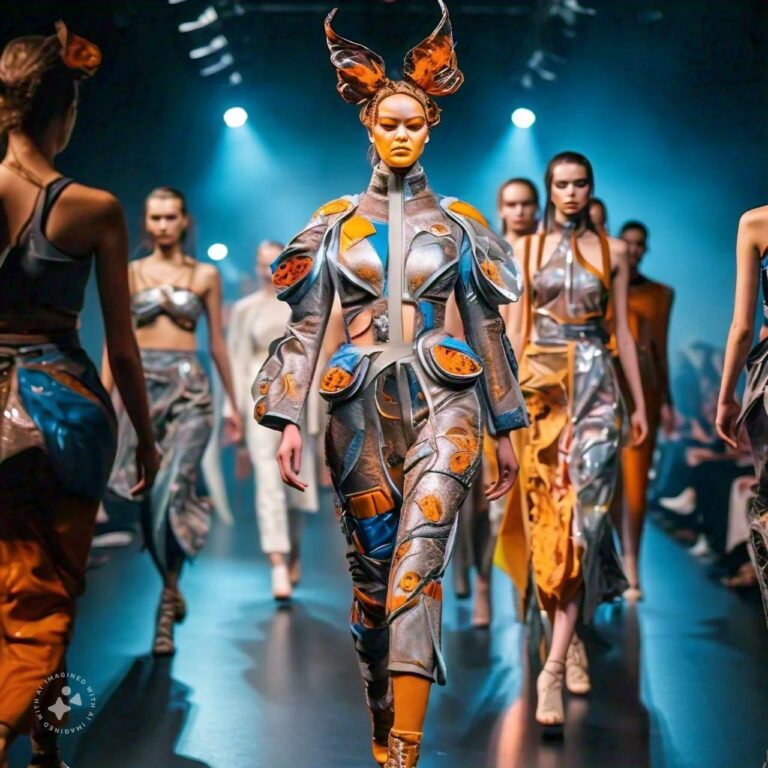Introduction
Defining Avant-Garde Fashion
Avant-garde fashion represents creativity and artistic expression while pushing the limits of traditional style. It is distinguished by its unorthodox approach to design, which frequently uses unusual materials, striking silhouettes, and avant-garde methods.This fashion style challenges traditional norms, aiming to create thought-provoking and groundbreaking pieces.
Importance of Avant-Garde in Modern Fashion
The development of contemporary fashion is significantly influenced by avant-garde fashion.It serves as a source of inspiration for mainstream designers and encourages the industry to embrace creativity and individuality. By breaking away from traditional aesthetics, avant-garde fashion paves the way for new trends and ideas, ensuring the continuous evolution of fashion.
Historical Context
Origins of Avant-Garde Fashion
The term “avant-garde” originated in the 19th century, referring to innovative and experimental ideas in art and culture. Avant-garde fashion emerged in the early 20th century, influenced by movements such as Dadaism and Surrealism. Designers like Elsa Schiaparelli and Yohji Yamamoto challenged conventional fashion norms, introducing radical designs that captured the essence of avant-garde.
Influential Designers and Movements
Key figures in avant-garde fashion include Rei Kawakubo of Comme des Garçons, known for her deconstructed designs, and Alexander McQueen, whose theatrical runway shows and innovative techniques left a lasting impact. Movements such as Futurism and Constructivism also played a significant role, inspiring designers to explore new materials and forms.
Characteristics of Avant-Garde Fashion
Innovation and Experimentation
The dedication to experimentation and creativity lies at the heart of avant-garde fashion. Designers push the boundaries of traditional garment construction, exploring new silhouettes, textures, and techniques. This approach often results in unexpected and provocative designs that challenge the viewer’s perception of fashion.
Unconventional Materials and Techniques
Unconventional materials like metal, plastic, and repurposed materials are commonly used in avant-garde fashion.These materials are manipulated using experimental techniques, creating unique and futuristic garments. The use of such materials not only enhances the visual appeal of the designs but also reflects the designer’s creative vision.
Current Trends in Avant-Garde Fashion
Emerging Designers to Watch
The avant-garde fashion scene is constantly evolving, with new designers emerging who continue to push the boundaries. Some of the noteworthy names include Iris van Herpen, known for her intricate 3D-printed designs, and Craig Green, who redefines menswear with his sculptural creations. These designers, who contribute new viewpoints and creative concepts, are the face of the future of avant-garde fashion.
Popular Avant-Garde Pieces and Styles
Current avant-garde fashion trends include oversized silhouettes, asymmetrical designs, and the use of bold, contrasting colors. Statement pieces like exaggerated coats, sculptural dresses, and futuristic accessories are popular among fashion-forward individuals who seek to make a bold style statement.
The Influence of Technology
Digital Fashion and Virtual Runways
For creative designers, the incorporation of technology into fashion has created new opportunities. Digital fashion, where garments are designed and displayed virtually, allows for limitless creativity. Virtual runways and fashion shows provide a platform for showcasing these innovative designs to a global audience, breaking down traditional barriers.
Wearable Technology and Smart Fabrics
Wearable technology and smart fabrics are increasingly being incorporated into avant-garde fashion. These innovations enhance the functionality and interactivity of garments, creating a seamless blend of fashion and technology. Examples include clothing with built-in LEDs, garments that change color based on temperature, and fabrics that monitor the wearer’s health.
Sustainability in Avant-Garde Fashion
Eco-Friendly Materials and Practices
Sustainability is a growing concern in the fashion industry, and avant-garde designers are leading the charge in adopting eco-friendly practices. They experiment with sustainable materials such as organic cotton, recycled fibers, and biodegradable fabrics. These efforts not only reduce the environmental impact but also highlight the designer’s commitment to ethical fashion.
The Role of Avant-Garde in Sustainable Fashion
Avant-garde fashion emphasis on innovation extends to sustainability. By challenging conventional production methods and exploring alternative materials, avant-garde designers are paving the way for a more sustainable future. Their work demonstrates that fashion can be both innovative and environmentally responsible.
The Future Landscape
Predictions for Avant-Garde Fashion
The future of avant-garde fashion is likely to be shaped by continued technological advancements and a growing focus on sustainability. We can expect to see even more innovative designs that incorporate smart technology and eco-friendly materials.With virtual fashion growing in popularity, the digital sphere will also be important.
Potential Impact on Mainstream Fashion
Avant-garde fashion’s influence on mainstream fashion is undeniable. As avant-garde designers continue to push the boundaries, their ideas and techniques will gradually filter into the mainstream, inspiring new trends and redefining contemporary fashion. This cross-pollination ensures that fashion remains dynamic and forward-thinking.
Conclusion
Avant-garde fashion represents the cutting edge of the fashion world, driving innovation and challenging conventions. By embracing experimentation and sustainability, avant-garde designers are shaping the future of fashion. As technology and environmental consciousness continue to evolve, the impact of avant-garde fashion on the broader industry will only grow, ensuring a vibrant and exciting future for fashion.
FAQs
- What is avant-garde fashion?
The inventive, experimental, and unorthodox approach to design that defines avant-garde fashion.
- Who are some influential avant-garde fashion designers?
Influential avant-garde designers include Rei Kawakubo, Alexander McQueen, and Iris van Herpen.
- How does technology influence avant-garde fashion?
Technology influences avant-garde fashion through digital fashion, virtual runways, wearable technology, and smart fabrics.
- What are some sustainable practices in avant-garde fashion?
Sustainable practices include using eco-friendly materials such as organic cotton and recycled fibers, and adopting ethical production methods.
- How does avant-garde fashion impact mainstream fashion?
Avant-garde fashion inspires mainstream fashion by introducing innovative designs and techniques that gradually become trends in the broader fashion industry.

